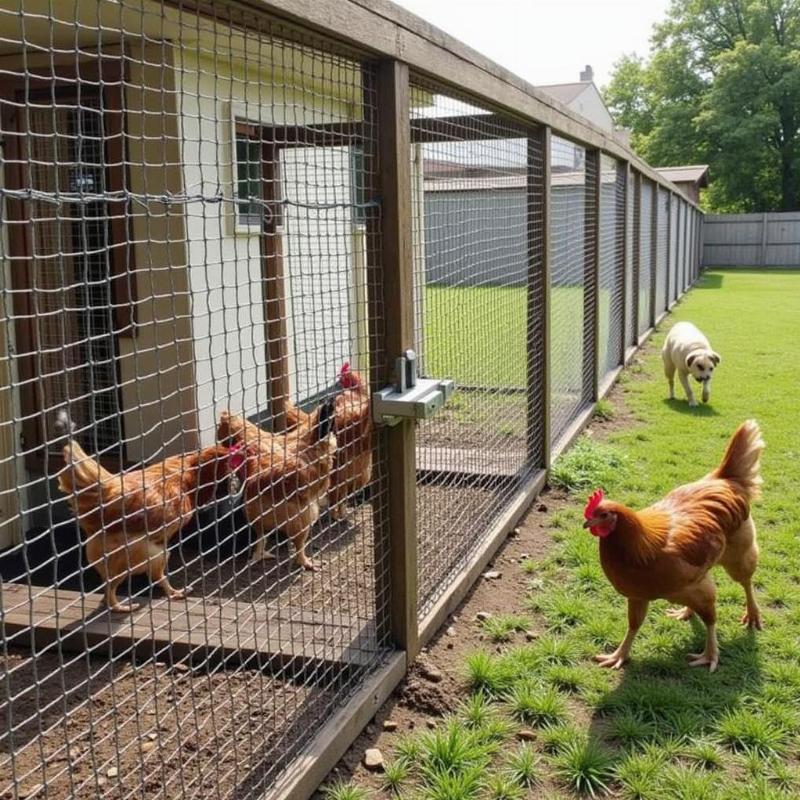A dog attack on a chicken can be a traumatic event for both animals, especially the chicken. Understanding the signs of shock in chickens and knowing how to provide immediate first aid can be crucial for their survival. This article will guide you through the steps to take if your chicken has been attacked by a dog, focusing on recognizing shock and providing appropriate care.
Recognizing Shock in a Chicken After a Dog Attack
After a dog attack, a chicken may exhibit several signs of shock, a life-threatening condition caused by reduced blood flow to vital organs. These signs can be subtle, so careful observation is critical.
- Pale comb and wattles: A healthy chicken’s comb and wattles are typically bright red. In a chicken experiencing shock, these areas will appear pale pink or even white.
- Rapid breathing: Notice if your chicken is breathing quickly and shallowly. This is a common symptom of shock.
- Weakness and lethargy: The chicken may appear unusually weak, unable to stand, or reluctant to move.
- Cold extremities: Feel the chicken’s feet and legs. If they are cold to the touch, this could indicate poor circulation, a sign of shock.
- Dilated pupils: The chicken’s eyes may appear wider than usual.
First Aid for a Chicken in Shock
If you suspect your chicken is in shock, swift action is vital. Here are the steps to take:
- Move the chicken to a safe, quiet place: Away from the dog and any other potential stressors. A darkened carrier or box can be helpful.
- Control bleeding: If there are any visible wounds, apply gentle pressure with a clean cloth to stop the bleeding.
- Keep the chicken warm: Wrap the chicken in a towel or blanket to help maintain its body temperature. A heating pad set on low can also be used, but ensure it doesn’t get too hot.
- Offer electrolytes: If the chicken is able to drink, offer a solution of electrolytes in water. This can help replenish lost fluids and stabilize its condition. Products like Pedialyte (unflavored) diluted with water can be used.
- Contact a veterinarian: Even if the chicken seems to be recovering, it’s essential to seek veterinary attention as soon as possible. Internal injuries may not be immediately apparent, and professional care is crucial for a full recovery.
Preventing Dog Attacks on Chickens
Protecting your chickens from dog attacks requires proactive measures.
- Secure fencing: Ensure your chicken coop and run are enclosed by sturdy fencing that a dog cannot dig under, climb over, or break through. Consider burying wire mesh along the fence perimeter to prevent digging.
- Supervised free-ranging: If you allow your chickens to free-range, do so only under close supervision, especially if dogs are present.
- Train your dog: If you own a dog, proper training is crucial. Teach your dog to leave chickens alone and reinforce this command consistently.
 Preventing Dog Attacks on Chickens
Preventing Dog Attacks on Chickens
Is my chicken going to survive a dog attack?
The survival rate of a chicken after a dog attack depends on the severity of the injuries and how quickly appropriate first aid and veterinary care are provided. Prompt action can significantly improve the chances of survival.
What if my dog keeps attacking my chickens?
If your dog repeatedly attacks your chickens despite training, consider seeking professional help from a certified dog trainer or animal behaviorist. They can help identify the underlying cause of the behavior and develop a tailored training plan.
Conclusion
A dog attack can be a terrifying experience for a chicken, and recognizing the signs of shock is paramount. By providing prompt first aid and seeking veterinary care, you can greatly increase your chicken’s chances of survival. Implementing preventative measures is equally important to protect your flock from future attacks. Remember, a secure coop, supervised free-ranging, and proper dog training are crucial for maintaining a safe and harmonious environment for both your chickens and your dog.
FAQ
- How long does shock last in a chicken? Shock can last for several hours, even with treatment.
- Can a chicken recover from shock on its own? While some chickens may recover from mild shock without intervention, it’s always best to seek veterinary care to address potential internal injuries and complications.
- What should I feed a chicken after a dog attack? Once stabilized, offer easily digestible foods like cooked rice, oatmeal, or scrambled eggs.
- How can I tell if my chicken has internal injuries? Internal injuries can be difficult to detect. Signs may include lethargy, loss of appetite, and difficulty breathing. A veterinarian can diagnose internal injuries through examination and imaging.
- Can a dog attack traumatize other chickens? Yes, witnessing a dog attack can be stressful for other chickens in the flock. Provide a calm and safe environment to help them recover.
- My chicken is hiding after the attack, is this normal? Yes, hiding is a natural response to fear and stress. Allow the chicken time to recover in a quiet and secure place.
- Should I separate the attacked chicken from the rest of the flock? If the chicken has injuries, separating it temporarily can help prevent further stress and allow for closer monitoring.
Beautdogs.us is your premier resource for comprehensive dog care information, breed-specific guidance, and access to top-quality products and services tailored to the US market. Whether you’re a seasoned dog owner or just starting your journey with a furry friend, Beautdogs.us offers expert advice and valuable resources to help you navigate the joys and responsibilities of dog ownership. Contact us today to learn more! Email: [email protected] Phone: +1 501-555-7529 Connect with us at Beautdogs.us.